Deep learning has an unquenchable thirst for processing resources. Classical deep learning has silently developed a bottleneck due to the interference of electrical impulses, energy usage, and physical constraints, even though electronic parts established on silicon can still sustain it presently. Academic and corporate circles are attempting to find new approaches for resolving electrical flaws that are less computationally intensive. It has huge benefits in information transmission and OC due to its high speed of 300,000 km per second, which is 300 times faster than that of an electron, and its data-carrying capacity and variety, which is 2 × 104 times greater than that of electric channels, as well as high parallelism and strong anti-interference. Switching electricity with light has emerged as a viable and sustainable work style, following the current trend.
- Optical Component
- Optical Functions
1. Spatial Light Modulator (SLM)
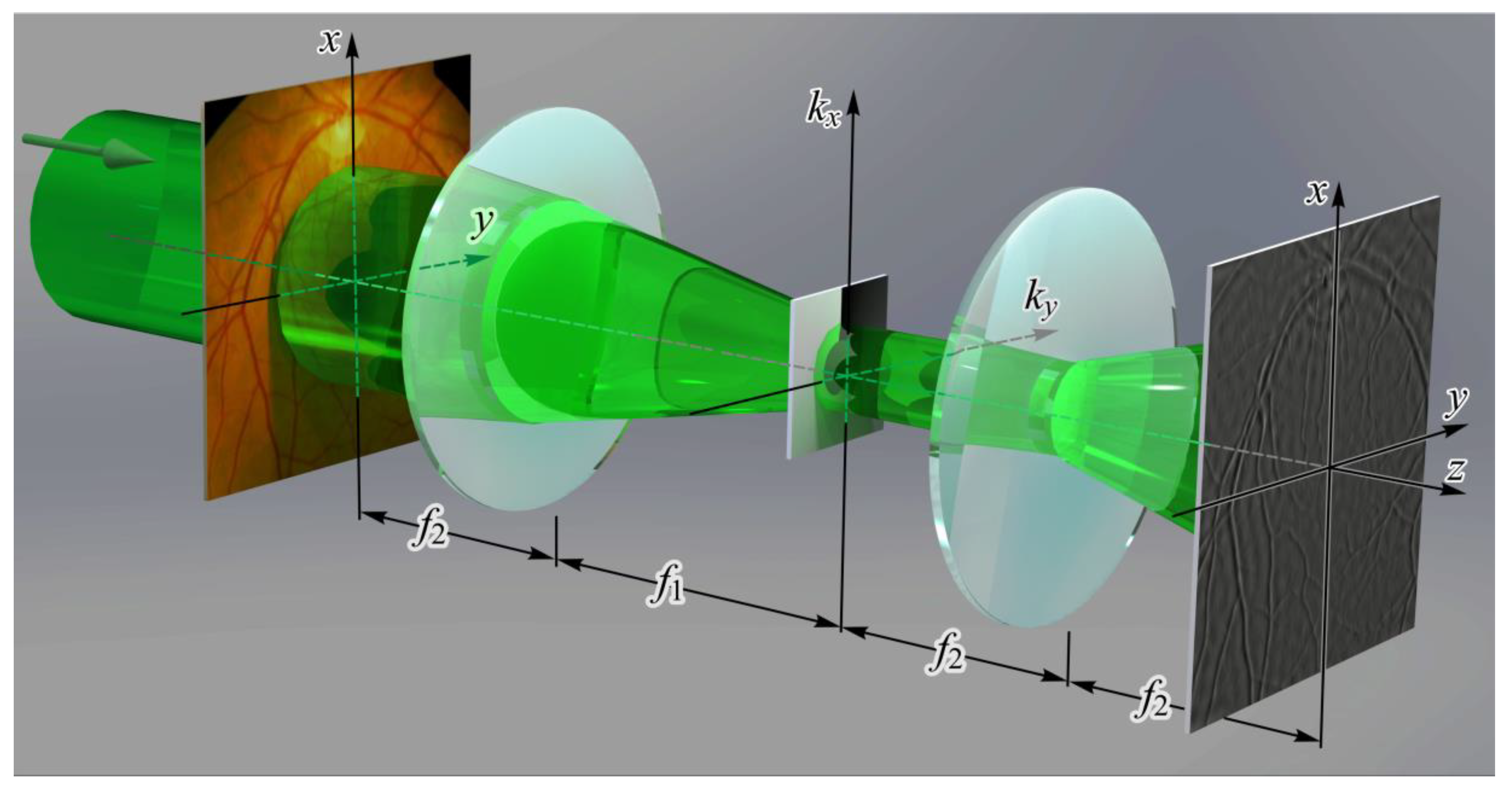
2. Plasmonic Switches
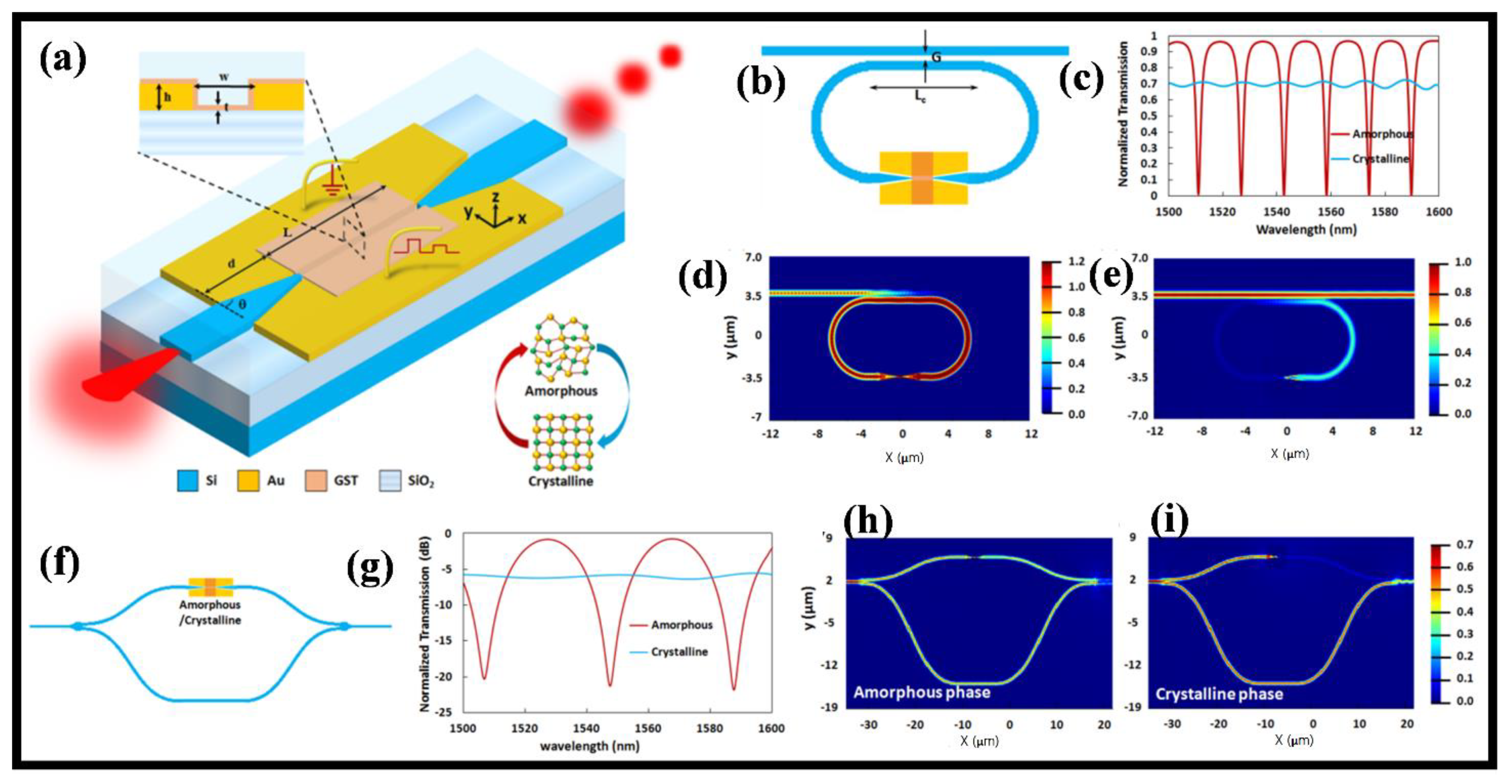
3. Neural Networks (NNs)
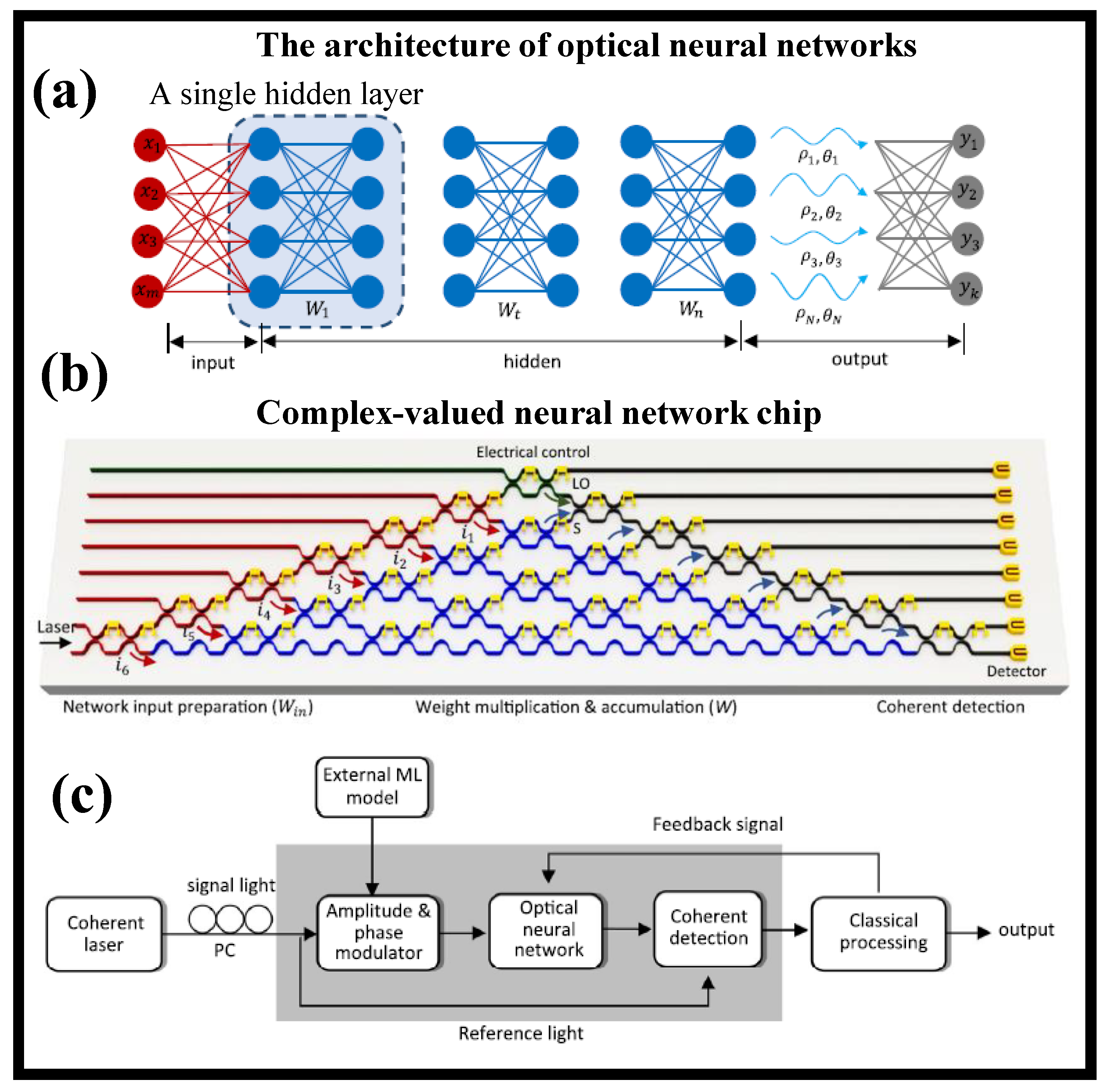
4. Diffractive NN
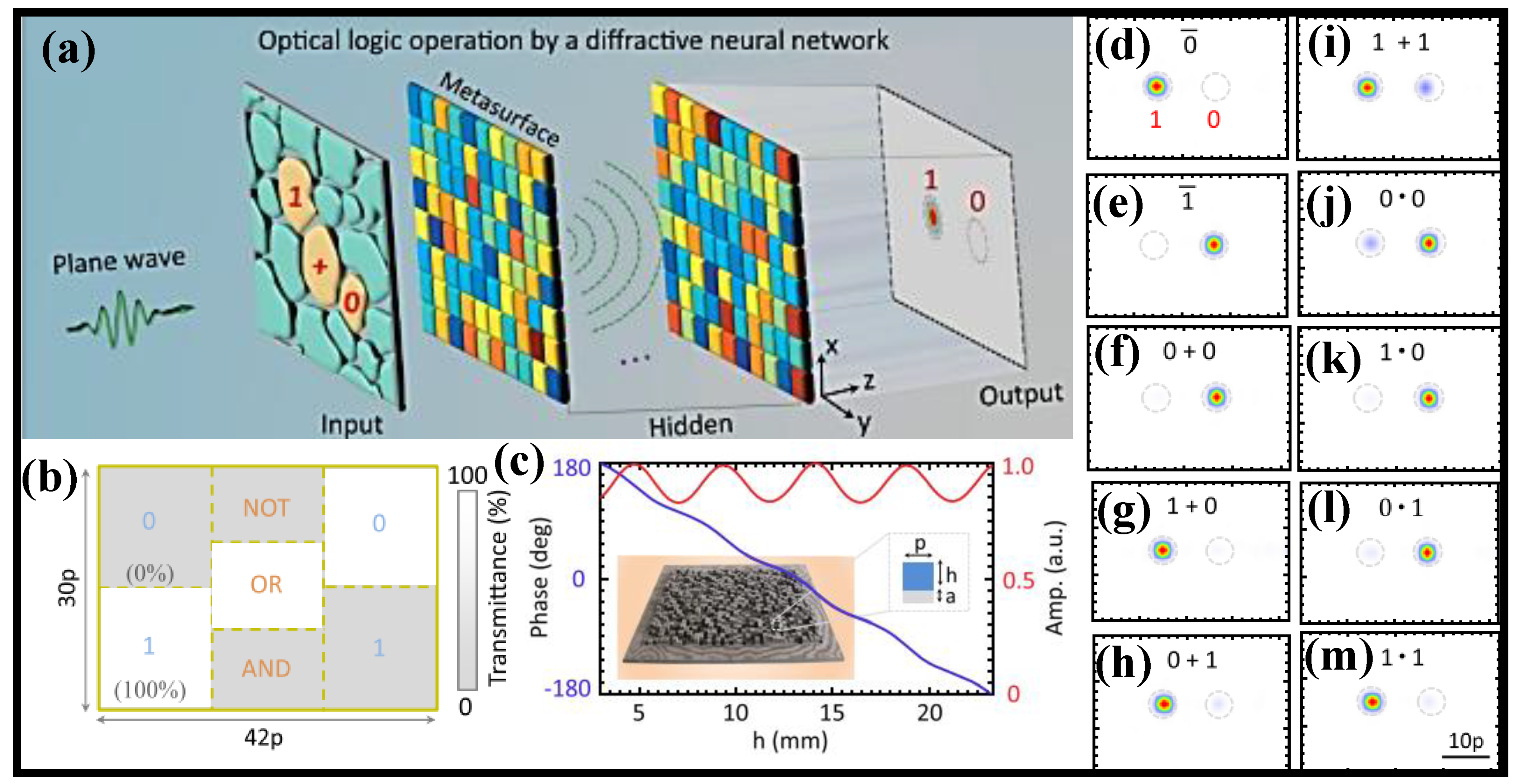
5. Photonic Crystal (PhC) All-Optical Logic Gates (OLGs)
- (a)
-
Non-PBG-based all-OLGs

- (b)
-
PBG-based all-OLGs
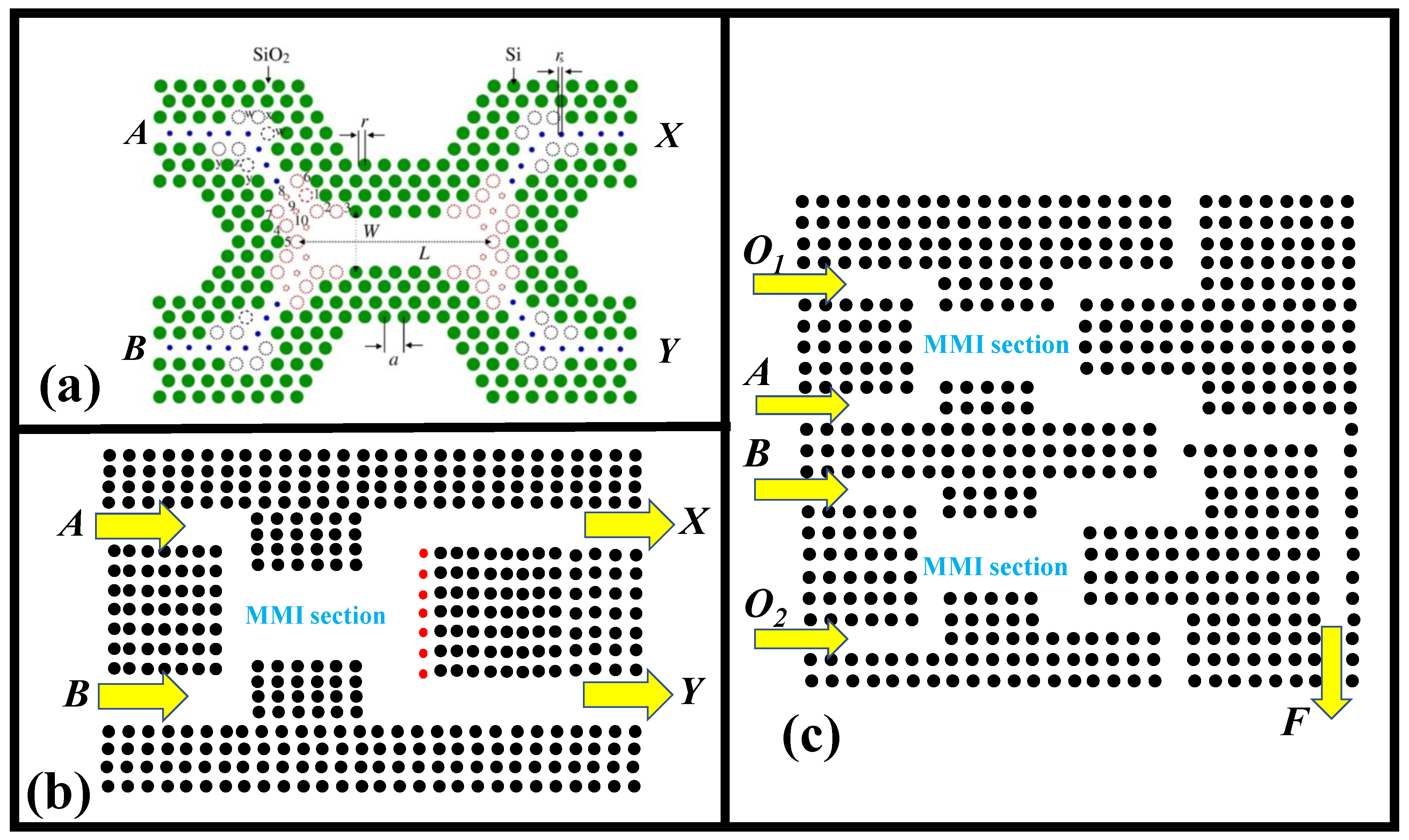
6. Resonant Nanophotonic Constructions
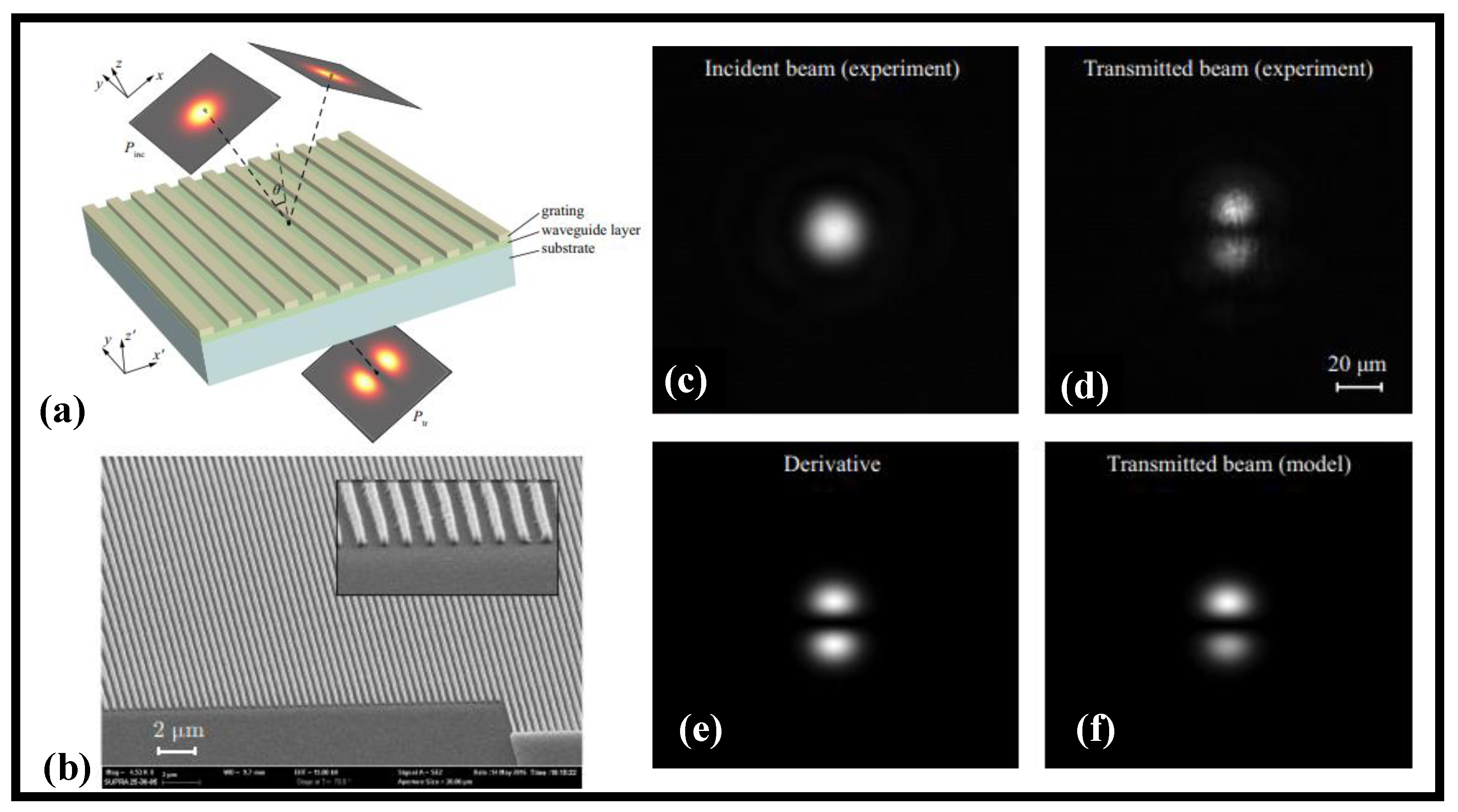
References
- Goodman, J. Introduction to Fourier Optics; McGraw-Hill: San Francisco, CA, USA, 1968.
- Carpenter, J. Holographic Mode Division Multiplexing in Optical Fibres; University of Cambridge: Cambridge, UK, 2012.
- Stroke, G.W. An Introduction to Coherent Optics and Holography; Academic Press: New York, NY, USA, 1966.
- Preston, K., Jr. Coherent Optical Computers; McGraw-Hill: New York, NY, USA, 1972.
- Lugt, A. Coherent optical processing. Proc. IEEE 1974, 62, 1300–1319.
- Perrin, M.; Metzger, G. Principles and feasibility of an optical preprocessor in high-energy physics. Nucl. Instrum. Methods 1975, 126, 509–518.
- Kotlyar, V.V.; Khonina, S.N.; Soĭfer, V.A. Light field decomposition in angular harmonics by means of diffractive optics. J. Mod. Opt. 1998, 45, 1495–1506.
- Khonina, S.N.; Kotlyar, V.V.; Soifer, V.A.; Paakkonen, P.; Turunen, J. Measuring the light field orbital angular momentum using DOE. Opt. Mem. Neural Netw. 2001, 10, 241–255.
- Kotlyar, V.V.; Khonina, S.N.; Soifer, V.A.; Wang, Y. Light field orbital angular moment measurement with the help of diffractive optical element. Avtometriya 2002, 38, 33–44.
- Kotlyar, V.V.; Kovalev, A.A.; Volyar, A.V. Topological charge of optical vortices and their superpositions. Comput. Opt. 2020, 44, 145–154.
- Reddy, A.N.K.; Anand, V.; Khonina, S.N.; Podlipnov, V.V.; Juodkazis, S. Robust Demultiplexing of Distinct Orbital Angular Momentum Infrared Vortex Beams Into Different Spatial Geometry Over a Broad Spectral Range. IEEE Access 2021, 9, 143341–143348.
- Porfirev, A.P.; Khonina, S.N. Experimental investigation of multi-order diffractive optical elements matched with two types of Zernike functions. Proc. SPIE 2016, 9807, 98070E.
- Degtyarev, S.A.; Porfirev, A.P.; Khonina, S.N. Zernike basis-matched multi-order diffractive optical elements for wavefront weak aberrations analysis. Proc. SPIE 2017, 10337, 103370Q.
- Khorin, P.A.; Volotovskiy, S.G.; Khonina, S.N. Optical detection of values of separate aberrations using a multi-channel filter matched with phase Zernike functions. Comput. Opt. 2021, 45, 525–533.
- Khonina, S.N.; Karpeev, S.V.; Porfirev, A.P. Wavefront Aberration Sensor Based on a Multichannel Diffractive Optical Element. Sensors 2020, 20, 3850.
- Khorin, P.A.; Porfirev, A.P.; Khonina, S.N. Adaptive Detection of Wave Aberrations Based on the Multichannel Filter. Photonics 2022, 9, 204.
- Soifer, V.A.; Golub, M.A.; Khonina, S.N. Decorrelated features of images extracted with the aid of optical Karhunen-Loeve expansion. Pattern Recognit. Image Anal. 1993, 3, 289–295.
- Soifer, V.A.; Khonina, S.N. Stability of the Karhunen-Loeve expansion in the problem of pattern recognition. Pattern Recognit. Image Anal. 1994, 4, 137–148.
- Soifer, V.A.; Kotlyar, V.V.; Khonina, S.N. An optical method of directions field construction. Avtometriya 1996, 1, 31–36.
- Soifer, V.A.; Kotlyar, V.V.; Khonina, S.N.; Skidanov, R.V. Optical methods of fingerprints identification. Comput. Opt. 1996, 16, 78–89.
- Soifer, V.; Kotlyar, V.; Khonina, S.; Skidanov, R. Optical–digital methods of fingerprint identification. Opt. Lasers Eng. 1998, 29, 351–359.
- Khonina, S.; Kotlyar, V.V.; Skidanov, R.V.; Soifer, V.; Soĭfer, V.A. Optodigital system for identifying fingerprints in real time. J. Opt. Technol. 2003, 70, 586–589.
- Khonina, S.N.; Demidov, A.S. Extended depth of focus through imaging system’s phase apodization in coherent and incoherent cases. Opt. Mem. Neural Netw. 2014, 23, 130–139.
- Khonina, S.N.; Ustinov, A.V. Generalized apodization of an incoherent imaging system aimed for extending the depth of focus. Pattern Recognit. Image Anal. 2015, 25, 626–631.
- Khonina, S.N.; Ustinov, A.V.; Porfirev, A.P. Dynamic focal shift and extending depth of focus based on the masking of the illuminating beam and using an adjustable axicon. J. Opt. Soc. Am. A 2019, 36, 1039–1047.
- Khonina, S.; Volotovskiy, S.; Dzyuba, A.; Serafimovich, P.; Popov, S.; Butt, M. Power Phase Apodization Study on Compensation Defocusing and Chromatic Aberration in the Imaging System. Electronics 2021, 10, 1327.
- Khonina, S.N.; Kotlyar, V.V.; Shinkaryev, M.V.; Soi-Fer, V.A.; Uspleniev, G.V. The Phase Rotor Filter. J. Mod. Opt. 1992, 39, 1147–1154.
- Ananin, M.A.; Khonina, S.N. Modelling of optical processing of images with use of the vortical spatial filter. Comput. Opt. 2009, 33, 466–472.
- Davis, J.A.; McNamara, D.E.; Cottrell, D.M.; Campos, J. Image processing with the radial Hilbert transform: Theory and experiments. Opt. Lett. 2000, 25, 99–101.
- Guo, C.-S.; Han, Y.-J.; Xu, J.-B.; Ding, J. Radial Hilbert transform with Laguerre-Gaussian spatial filters. Opt. Lett. 2006, 31, 1394–1396.
- Lazarev, G.; Hermerschmidt, A. LCOS Spatial Light Modulators: Trends and Applications. In Optical Imaging and Metrology: Advanced Technologies; Osten, W., Reingand, N., Eds.; Wiley-VCH: Weinheim, Germany, 2012; pp. 1–29.
- Pivnenko, M.; Li, K.; Chu, D. Sub-millisecond switching of multi-level liquid crystal on silicon spatial light modulators for increased information bandwidth. Opt. Express 2021, 29, 24614–24628.
- Jin, D.; Zhou, R.; Yaqoob, Z.; So, P.T.C. Dynamic spatial filtering using a digital micromirror device for high-speed optical diffraction tomography. Opt. Express 2018, 26, 428–437.
- Turtaev, S.; Leite, I.T.; Mitchell, K.J.; Padgett, M.J.; Phillips, D.B.; Cizmar, T. Comparison of nematic liquid-crystal and DMD based spatial light modulation in complex photonics. Opt. Express 2017, 25, 29874–29884.
- Phase Spatial Light Modulator LCOS-SLM. Available online: https://www.hamamatsu.com/eu/en/product/optical-components/lcos-slm.html (accessed on 23 June 2022).
- Kovachev, M.; Ilieva, R.; Onural, L.; Esmer, G.B.; Reyhan, T.; Benzie, P.; Watson, J.; Mitev, E. Reconstruction of Computer Generated Holograms by Spatial Light Modulators. In Multimedia Content Representation, Classification and Security; Gunsel, B., Jain, A.K., Tekalp, A.M., Sankur, B., Eds.; Springer: Berlin/Heidelberg, Germany, 2006; pp. 706–713.
- Younus, S.H.; Hussein, A.T.; Alresheedi, M.T.; Elmirghani, J. CGH for Indoor Visible Light Communication System. IEEE Access 2017, 5, 24988–25004.
- Torii, Y.; Balladares-Ocaña, L.; Martinez-Castro, J. An Iterative Fourier Transform Algorithm for digital hologram generation using phase-only information and its implementation in a fixed-point digital signal processor. Optik 2013, 124, 5416–5421.
- Kettunen, V.; Ripoll, O.; Herzig, H.P. Review of iterative Fourier-transform algorithms for beam shaping applications. Opt. Eng. 2004, 43, 2549–2556.
- Roelens, M.A.F.; Frisken, S.; Bolger, J.A.; Abakoumov, D.; Baxter, G.; Poole, S.; Eggleton, B.J. Dispersion Trimming in a Reconfigurable Wavelength Selective Switch. J. Light. Technol. 2008, 26, 73–78.
- Wang, M.; Zong, L.; Mao, L.; Marquez, A.; Ye, Y.; Zhao, H.; Caballero, F.J.V. LCoS SLM Study and Its Application in Wavelength Selective Switch. Photonics 2017, 4, 22.
- Turunen, J.; Wyrowski, F. Diffractive Optics for Industrial and Commercial Applications; John Wiley and Sons: Hoboken, NJ, USA, 1997.
- Osten, W.; Kohler, C.; Liesener, J. Evaluation and Application of Spatial Light Modulators for Optical Metrology. Opt. Pura Apl. 2005, 38, 71–81.
- Varga, J.J.M.; A Solís-Prosser, A.M.; Rebón, L.; Arias, A.; Neves, L.; Iemmi, C.; Ledesma, S. Preparing arbitrary pure states of spatial qudits with a single phase-only spatial light modulator. J. Phys. Conf. Ser. 2015, 605, 012035.
- Schröder, J.; Roelens, M.; Du, L.; Lowery, A.; Eggleton, B. LCOS based waveshaper technology for optical signal processing and performance monitoring. In Proceedings of the 17th Opto-Electronics and Communications Conference, Busan, Korea, 2–6 July 2012; pp. 859–860.
- Barbier, P.; Moddel, G. Spatial light modulators: Processing light in real time. Opt. Photon. News 1997, 8, 17–21.
- Shrestha, P.K.; Chun, Y.T.; Chu, D. A high-resolution optically addressed spatial light modulator based on ZnO nanoparticles. Light. Sci. Appl. 2015, 4, e259.
- Chen, P.; Ma, L.-L.; Hu, W.; Shen, Z.-X.; Bisoyi, H.K.; Wu, S.-B.; Ge, S.-J.; Li, Q.; Lu, Y.-Q. Chirality invertible superstructure mediated active planar optics. Nat. Commun. 2019, 10, 2518.
- Smith, D. Lasers, nonlinear optics and optical computers. Nature 1985, 316, 319–324.
- Shih, M.Y.; Shishido, A.; Khoo, I.C. All-optical image processing by means of a photosensitive nonlinear liquid-crystal film: Edge enhancement and image addition–subtraction. Opt. Lett. 2001, 26, 1140–1142.
- Zhang, J.; Wang, H.; Yoshikado, S.; Aruga, T. Incoherent-to-coherent conversion by use of the photorefractive fanning effect. Opt. Lett. 1997, 22, 1612–1614.
- Woods, D.; Naughton, T.J. Photonic neural networks. Nat. Phys. 2012, 8, 257–259.
- Solodar, A.; Kumar, T.A.; Sarusi, G.; Abdulhalim, I. Infrared to visible image up-conversion using optically addressed spatial light modulator utilizing liquid crystal and InGaAs photodiodes. Appl. Phys. Lett. 2016, 108, 021103.
- Kirzhner, M.G.; Klebanov, M.; Lyubin, V.; Collings, N.; Abdulhalim, I. Liquid crystal high-resolution optically addressed spatial light modulator using a nanodimensional chalcogenide photosensor. Opt. Lett. 2014, 39, 2048–2051.
- Li, S.-Q.; Xu, X.; Veetil, R.M.; Valuckas, V.; Paniagua-Domínguez, R.; Kuznetsov, A.I. Phase-only transmissive spatial light modulator based on tunable dielectric metasurface. Science 2019, 364, 1087–1090.
- Li, J.; Yu, P.; Zhang, S.; Liu, N. Electrically-controlled digital metasurface device for light projection displays. Nat. Commun. 2020, 11, 3574.
- Park, J.; Gil Jeong, B.; Kim, S.I.; Lee, D.; Kim, J.; Shin, C.; Lee, C.B.; Otsuka, T.; Kyoung, J.; Kim, S.; et al. All-solid-state spatial light modulator with independent phase and amplitude control for three-dimensional LiDAR applications. Nat. Nanotechnol. 2020, 16, 69–76.
- Gong, S.; Ren, M.; Wu, W.; Cai, W.; Xu, J. Optically addressed spatial light modulator based on nonlinear metasurface. Photon. Res. 2021, 9, 610.
- Heck, M. Optical Computers Light Up the Horizon. 2018. Available online: https://phys.org/news/2018-03-optical-horizon.html (accessed on 28 April 2022).
- Waldrop, M. The chips are down for Moore’s law. Nat. News 2016, 530, 144.
- Atabaki, A.H.; Moazeni, S.; Pavanello, F.; Gevorgyan, H.; Notaros, J.; Alloatti, L.; Wade, M.T.; Sun, C.; Kruger, S.A.; Meng, H.; et al. Integrating photonics with silicon nanoelectronics for the next generation of systems on a chip. Nature 2018, 556, 349–354.
- Paniccia, M. A perfect marriage: Optics and silicon: Integrated silicon-based photonics now running at 50 Ggps, with Terabit speeds on the horizon. Optik. Photon. 2011, 6, 34–38.
- Liu, K.; Ye, C.R.; Khan, S.; Sorger, V.J. Review and perspective on ultrafast wavelength-size electro-optic modulators. Laser Photon. Rev. 2015, 9, 172–194.
- Chung, S.; Nakai, M.; Hashemi, H. Low-power thermo-optic silicon modulator for large-scale photonic integrated systems. Opt. Express 2019, 27, 13430–13459.
- Lee, B.; Biberman, A.; Chan, J.; Bergman, K. High-Performance Modulators and Switches for Silicon Photonic Networks-on-Chip. IEEE J. Sel. Top. Quantum Electron. 2009, 16, 6–22.
- Ying, Z.; Feng, C.; Zhao, Z.; Soref, R.; Pan, D.; Chen, R.T. Integrated multi-operand electro-optic logic gates for optical computing. Appl. Phys. Lett. 2019, 115, 171104.
- Xiao, X.; Xu, H.; Li, X.; Li, Z.; Chu, T.; Yu, Y.; Yu, J. High-speed, low-loss silicon Mach–Zehnder modulators with doping optimization. Opt. Express 2013, 21, 4116–4125.
- Shu, H.-W.; Jin, M.; Tao, Y.-S.; Wang, X.-J. Graphene-based silicon modulators. Front. Inf. Technol. Electron. Eng. 2019, 20, 458–471.
- Zhang, Q.; Zhang, Y.; Li, J.; Soref, R.; Gu, T.; Hu, J. Broadband nonvolatile photonic switching based on optical phase change materials: Beyond the classical figure-of-merit. Opt. Lett. 2017, 43, 94–97.
- Yang, Z.; Ramanathan, S. Breakthroughs in Photonics 2014: Phase Change Materials for Photonics. IEEE Photon. J. 2015, 7, 1–5.
- Badri, S.H.; Farkoush, S.G. Subwavelength grating waveguide filter based on cladding modulation with a phase-change material grating. Appl. Opt. 2021, 60, 2803–2810.
- Wang, J.; Wang, L.; Liu, J. Overview of Phase-Change Materials Based Photonic Devices. IEEE Access 2020, 8, 121211–121245.
- Badri, S.H.; Gilarlue, M.M.; Farkoush, S.G.; Rhee, S.-B. Reconfigurable bandpass optical filters based on subwavelength grating waveguides with a Ge2Sb2 Te5 cavity. J. Opt. Soc. Am. B 2021, 38, 1283–1289.
- Ghosh, R.; Dhawan, A. Integrated non-volatile plasmonic switches based on phase-change-materials and their application to plasmonic logic circuits. Sci. Rep. 2021, 11, 18811.
- Prieto, A.; Prieto, B.; Ortigosa, E.M.; Ros, E.; Pelayo, F.; Ortega, J.; Rojas, I. Neural networks: An overview of early research, current frameworks and new challenges. Neurocomputing 2016, 214, 242–268.
- LeCun, Y.; Bengio, Y.; Hinton, G. Deep learning. Nature 2015, 521, 436–444.
- Krizhevsky, A.; Sutskever, I.; Hinton, G.E. Imagenet classification with deep convolutional neural networks. NIPS 2012, 60, 84–90.
- Nitta, T. Orthogonality of Decision Boundaries in Complex-Valued Neural Networks. Neural Comput. 2004, 16, 73–97.
- Aizenberg, I. Complex-Valued Neural Networks with Multi-Valued Neurons; Springer: Berlin/Heidelberg, Germany, 2011.
- Peng, H.-T.; Nahmias, M.A.; De Lima, T.F.; Tait, A.N.; Shastri, B.J. Neuromorphic Photonic Integrated Circuits. IEEE J. Sel. Top. Quantum Electron. 2018, 24, 1–15.
- Sze, V.; Chen, Y.-H.; Yang, T.-J.; Emer, J.S. Efficient Processing of Deep Neural Networks: A Tutorial and Survey. Proc. IEEE 2017, 105, 2295–2329.
- de Lima, T.F.; Peng, H.-T.; Tait, A.N.; Nahmias, M.A.; Miller, H.B.; Shastri, B.J.; Prucnal, P.R. Machine Learning With Neuromorphic Photonics. J. Light. Technol. 2019, 37, 1515–1534.
- Lin, X.; Rivenson, Y.; Yardimci, N.T.; Veli, M.; Luo, Y.; Jarrahi, M.; Ozcan, A. All-optical machine learning using diffractive deep neural networks. Science 2018, 361, 1004–1008.
- Vandoorne, K.; Mechet, P.; Van Vaerenbergh, T.; Fiers, M.; Morthier, G.; Verstraeten, D.; Schrauwen, B.; Dambre, J.; Bienstman, P. Experimental demonstration of reservoir computing on a silicon photonics chip. Nat. Commun. 2014, 5, 3541.
- Harris, N.C.; Carolan, J.; Bunandar, D.; Prabhu, M.; Hochberg, M.; Baehr-Jones, T.; Fanto, M.L.; Smith, A.M.; Tison, C.C.; Alsing, P.M.; et al. Linear programmable nanophotonic processors. Optica 2018, 5, 1623–1631.
- Williamson, I.A.D.; Hughes, T.W.; Minkov, M.; Bartlett, B.; Pai, S.; Fan, S. Reprogrammable Electro-Optic Nonlinear Activation Functions for Optical Neural Networks. IEEE J. Sel. Top. Quantum Electron. 2019, 26, 1–12.
- Bueno, J.; Maktoobi, S.; Froehly, L.; Fischer, I.; Jacquot, M.; Larger, L.; Brunner, D. Reinforcement learning in a large-scale photonic recurrent neural network. Optica 2018, 5, 756–760.
- Ambrogio, S.; Narayanan, P.; Tsai, H.; Shelby, R.M.; Boybat, I.; Di Nolfo, C.; Sidler, S.; Giordano, M.; Bodini, M.; Farinha, N.C.P.; et al. Equivalent-accuracy accelerated neural-network training using analogue memory. Nature 2018, 558, 60–67.
- Li, C.; Belkin, D.; Li, Y.; Yan, P.; Hu, M.; Ge, N.; Jiang, H.; Montgomery, E.; Lin, P.; Wang, Z.; et al. Efficient and self-adaptive in-situ learning in multilayer memristor neural networks. Nat. Commun. 2018, 9, 2385.
- Yao, P.; Wu, H.; Gao, B.; Tang, J.; Zhang, Q.; Zhang, W.; Yang, J.J.; Qian, H. Fully hardware-implemented memristor convolutional neural network. Nature 2020, 577, 641–646.
- Rakkiyappan, R.; Velmurugan, G.; Li, X. Complete Stability Analysis of Complex-Valued Neural Networks with Time Delays and Impulses. Neural Process. Lett. 2014, 41, 435–468.
- Wang, H.; Duan, S.; Huang, T.; Wang, L.; Li, C. Exponential Stability of Complex-Valued Memristive Recurrent Neural Networks. IEEE Trans. Neural Netw. Learn. Syst. 2016, 28, 766–771.
- Velmurugan, G.; Rakkiyappan, R.; Vembarasan, V.; Cao, J.; Alsaedi, A. Dissipativity and stability analysis of fractional-order complex-valued neural networks with time delay. Neural Netw. 2016, 86, 42–53.
- Hirose, A. Applications of complex-valued neural networks to coherent optical computing using phase-sensitive detection scheme. Inf. Sci. Appl. 1994, 2, 103–117.
- Zhang, H.; Gu, M.; Jiang, X.D.; Thompson, J.; Cai, H.; Paesani, S.; Santagati, R.; Laing, A.; Zhang, Y.; Yung, M.H.; et al. An optical neural chip for implementing complex-valued neural network. Nat. Commun. 2021, 12, 457.
- Wei, H.; Wang, Z.; Tian, X.; Käll, M.; Xu, H. Cascaded logic gates in nanophotonic plasmon networks. Nat. Commun. 2011, 2, 387.
- Wei, H.; Li, Z.; Tian, X.; Wang, Z.; Cong, F.; Liu, N.; Zhang, S.; Nordlander, P.; Halas, N.J.; Xu, H. Quantum Dot-Based Local Field Imaging Reveals Plasmon-Based Interferometric Logic in Silver Nanowire Networks. Nano Lett. 2011, 11, 471–475.
- Fu, Y.; Hu, X.; Lu, C.; Yue, S.; Yang, H.; Gong, Q. All-Optical Logic Gates Based on Nanoscale Plasmonic Slot Waveguides. Nano Lett. 2012, 12, 5784–5790.
- Sang, Y.; Wu, X.; Raja, S.S.; Wang, C.-Y.; Li, H.; Ding, Y.; Liu, D.; Zhou, J.; Ahn, H.; Gwo, S.; et al. Broadband Multifunctional Plasmonic Logic Gates. Adv. Opt. Mater. 2018, 6, 1701368.
- Xu, Q.; Lipson, M. All-optical logic based on silicon micro-ring resonators. Opt. Express 2007, 15, 924–929.
- Raeker, B.O.; Grbic, A. Compound Metaoptics for Amplitude and Phase Control of Wave Fronts. Phys. Rev. Lett. 2019, 122, 113901.
- Khonina, S.N.; Kazanskiy, N.L.; Karpeev, S.V.; Butt, M.A. Bessel Beam: Significance and Applications—A Progressive Review. Micromachines 2020, 11, 997.
- Qian, C.; Lin, X.; Lin, X.; Xu, J.; Sun, Y.; Li, E.; Zhang, B.; Chen, H. Performing optical logic operations by a diffractive neural network. Light. Sci. Appl. 2020, 9, 59.
- Onifade, A. History of the computer. IEEE Conf. Hist. Electron. 2004, 21, 1–20.
- Cotter, D.; Manning, R.J.; Blow, K.J.; Ellis, A.D.; Kelly, A.E.; Nesset, D.; Phillips, I.D.; Poustie, A.J.; Rogers, D.C. Nonlinear Optics for High-Speed Digital Information Processing. Science 1999, 286, 1523–1528.
- Suzuki, Y.; Shimada, J.; Yamashita, H. High-speed optical-optical logic gate for optical computers. Electron. Lett. 1985, 21, 161–162.
- Meindl, J. Low power microelectronics: Retrospect and prospect. Proc. IEEE 1995, 83, 619–635.
- Yavuz, D. All-optical femtosecond switch using two-photon absorption. Phys. Rev. A 2006, 74, 053804.
- Kim, J.H.; Jhon, Y.M.; Byun, Y.T.; Lee, S.; Woo, D.H.; Kim, S.H. All-optical XOR gate using semiconductor optical amplifiers without additional input beam. IEEE Photon. Technol. Lett. 2002, 14, 1436–1438.
- Sharaiha, A.; Topomondzo, J.; Morel, P. All-optical logic AND–NOR gate with three inputs based on cross-gain modulation in a semiconductor optical amplifier. Opt. Commun. 2006, 265, 322–325.
- Nesset, D.; Cotter, D.; Tatham, M. All-optical AND gate operating on 10 Gbit/s signals at the same wavelength using four-wave mixing in a semiconductor laser amplifier. Electron. Lett. 1995, 31, 896–897.
- Webb, R.; Manning, R.; Maxwell, G.; Poustie, A. 40 Gbit∕s all-optical XOR gate based on hybrid-integrated Mach-Zehnder interferometer. Electron. Lett. 2003, 39, 79–81.
- Wu, Y.-D.; Shih, T.-T.; Chen, M.-H. New all-optical logic gates based on the local nonlinear Mach-Zehnder interferometer. Opt. Express 2008, 16, 248–257.
- McGeehan, J.; Giltrelli, M.; Willner, A. All-optical digital 3-input AND gate using sum- and difference-frequency generation in PPLN waveguide. Electron. Lett. 2007, 43, 409–410.
- Wang, J.; Sun, J.; Sun, Q. Single-PPLN-based simultaneous half-adder, half-subtracter, and OR logic gate: Proposal and simulation. Opt. Express 2007, 15, 1690–1699.
- Butt, M.A.; Kazanskiy, N.L. Two-dimensional photonic crystal heterostructure for light steering and TM-polarization maintaining applications. Laser Phys. 2021, 31, 036201.
- Butt, M.; Khonina, S.; Kazanskiy, N. 2D-Photonic crystal heterostructures for the realization of compact photonic devices. Photon. Nanostruct. Fundam. Appl. 2021, 44, 100903.
- Kazanskiy, N.; Butt, M.; Khonina, S. 2D-Heterostructure Photonic Crystal Formation for On-Chip Polarization Division Multiplexing. Photonics 2021, 8, 313.
- Kazanskiy, N.L.; Butt, M.A. One-dimensional photonic crystal waveguide based on SOI platform for transverse magnetic polarization-maintaining devices. Photon. Lett. Pol. 2020, 12, 85–87.
- John, S. Strong localization of photons in certain disordered dielectric superlattices. Phys. Rev. Lett. 1987, 58, 2486–2489.
- Zhang, Y.; Zhang, Y.; Li, B. Optical switches and logic gates based on self-collimated beams in two-dimensional photonic crystals. Opt. Express 2007, 15, 9287–9292.
- Fan, R.; Yang, X.; Meng, X.; Sun, X. 2D photonic crystal logic gates based on self-collimated effect. J. Phys. D Appl. Phys. 2016, 49, 325104.
- Christina, X.S.; Kabilan, A.P. Design of optical logic gates using self-collimated beams in 2D photonic crystal. Photon. Sens. 2012, 2, 173–179.
- Ishizaka, Y.; Kawaguchi, Y.; Saitoh, K.; Koshiba, M. Design of ultra compact all-optical XOR and AND logic gates with low power consumption. Opt. Commun. 2011, 284, 3528–3533.
- Hou, J.; Gao, D.; Wu, H.; Zhou, Z. Polarization insensitive self-collimation waveguide in square lattice annular photonic crystals. Opt. Commun. 2009, 282, 3172–3176.
- Lin, Y.; Tang, C.; Yin, H.; Hao, Y.; Wu, C. Design and optimization of all-optical AND and NOR Logic Gates in a Two-Dimensional Photonic Crystal for Binary-Phase-Shift-Keyed Signals. In Proceedings of the 7th Int Conf on Biomedical Engineering and Informatics, Dalian, China, 14–16 October 2014; pp. 965–969.
- Liu, W.; Yang, D.; Shen, G.; Tian, H.; Ji, Y. Design of ultra compact all-optical XOR, XNOR, NAND and OR gates using photonic crystal multi-mode interference waveguides. Opt. Laser Technol. 2013, 50, 55–64.
- Shaik, E.H.; Rangaswamy, N. Multi-mode interference-based photonic crystal logic gates with simple structure and improved contrast ratio. Photon. Netw. Commun. 2017, 34, 140–148.
- Serajmohammadi, S.; Absalan, H. All optical NAND gate based on nonlinear photonic crystal ring resonator. Inf. Process. Agric. 2016, 3, 119–123.
- Rani, P.; Fatima, S.; Kalra, Y.; Sinha, R. Realization of all optical logic gates using universal NAND gates on photonic crystal platform. Superlattices Microstruct. 2017, 109, 619–625.
- Younis, R.M.; Areed, N.F.F.; Obayya, S.S.A. Fully Integrated AND and OR Optical Logic Gates. IEEE Photon. Technol. Lett. 2014, 26, 1900–1903.
- Rao, D.G.S.; Swarnakar, S.; Kumar, S. Performance analysis of all-optical NAND, NOR, and XNOR logic gates using photonic crystal waveguide for optical computing applications. Opt. Eng. 2020, 59, 057101.
- Parandin, F.; Karkhanehchi, M.M. Terahertz all-optical NOR and AND logic gates based on 2D photonic crystals. Superlattices Microstruct. 2017, 101, 253–260.
- Pirzadi, M.; Mir, A.; Bodaghi, D. Realization of Ultra-Accurate and Compact All-Optical Photonic Crystal OR Logic Gate. IEEE Photon. Technol. Lett. 2016, 28, 2387–2390.
- Sun, C.; Wade, M.T.; Lee, Y.; Orcutt, J.S.; Alloatti, L.; Georgas, M.S.; Waterman, A.S.; Shainline, J.M.; Avizienis, R.R.; Lin, S.; et al. Single-chip microprocessor that communicates directly using light. Nature 2015, 528, 534–538.
- Silva, A.; Monticone, F.; Castaldi, G.; Galdi, V.; Alù, A.; Engheta, N. Performing Mathematical Operations with Metamaterials. Science 2014, 343, 160–163.
- Solli, D.R.; Jalali, B. Analog optical computing. Nat. Photon. 2015, 9, 704–706.
- Pors, A.; Nielsen, M.G.; Bozhevolnyi, S.I. Analog Computing Using Reflective Plasmonic Metasurfaces. Nano Lett. 2014, 15, 791–797.
- Ferrera, M.; Park, Y.; Razzari, L.; Little, B.E.; Chu, S.T.; Morandotti, R.; Moss, D.J.; Azana, J. On-chip CMOS-compatible all-optical integrator. Nat. Commun. 2010, 1, 29.
- Pasquazi, A.; Peccianti, M.; Park, Y.; Little, B.E.; Chu, S.T.; Morandotti, R.; Azaña, J.; Moss, D.J. Sub-picosecond phase-sensitive optical pulse characterization on a chip. Nat. Photon. 2011, 5, 618–623.
- Ruiz, M.D.R.F.; Carballar, A.; Azaña, J. Design of Ultrafast All-Optical Signal Processing Devices Based on Fiber Bragg Gratings in Transmission. J. Light. Technol. 2013, 31, 1593–1600.
- Asghari, M.H.; Azana, J. Photonic Integrator-Based Optical Memory Unit. IEEE Photon. Technol. Lett. 2010, 23, 209–211.
- Ashrafi, R.; Azaña, J. Figure of merit for photonic differentiators. Opt. Express 2012, 20, 2626–2639.
- Rutkowska, K.; Duchesne, D.; Strain, M.; Morandotti, R.; Sorel, M.; Azaña, J. Ultrafast all-optical temporal differentiators based on CMOS-compatible integrated-waveguide Bragg gratings. Opt. Express 2011, 19, 19514–19522.
- Li, M.; Janner, D.; Yao, J.; Pruneri, V. Arbitrary-order all-fiber temporal differentiator based on a fiber Bragg grating: Design and experimental demonstration. Opt. Express 2009, 17, 19798–19807.
- Tan, S.; Wu, Z.; Lei, L.; Hu, S.; Dong, J.; Zhang, X. All-optical computation system for solving differential equations based on optical intensity differentiator. Opt. Express 2013, 21, 7008–7013.
- Tan, S.; Xiang, L.; Zou, J.; Zhang, Q.; Wu, Z.; Yu, Y.; Dong, J.; Zhang, X. High-order all-optical differential equation solver based on microring resonators. Opt. Lett. 2013, 38, 3735–3738.
- Lu, L.; Wu, J.; Wang, T.; Su, Y. Compact all-optical differential-equation solver based on silicon microring resonator. Front. Optoelectron. 2012, 5, 99–106.
- Yang, T.; Dong, J.; Lu, L.; Zhou, L.; Zheng, A.; Zhang, X.; Chen, J. All-optical differential equation solver with constant-coefficient tunable based on a single microring resonator. Sci. Rep. 2014, 4, 05581.
- Bykov, D.A.; Doskolovich, L.L.; Soifer, V.A. Integration of optical pulses by resonant diffraction gratings. J. Exp. Theor. Phys. Lett. 2012, 95, 6–9.
- Soifer, V.A. (Ed.) Diffractive Optics and Nanophotonics; CRC Press: Boca Raton, FL, USA, 2017; Available online: https://www.routledge.com/Diffractive-Optics-and-Nanophotonics/Soifer/p/book/9780367573102 (accessed on 12 May 2022).
- Bykov, D.; Doskolovich, L.L.; Golovastikov, N.; Soifer, V. Time-domain differentiation of optical pulses in reflection and in transmission using the same resonant grating. J. Opt. 2013, 15, 105703.
- Bykov, D.A.; Doskolovich, L.L.; Soifer, V.A. Temporal differentiation of optical signals using resonant gratings. Opt. Lett. 2011, 36, 3509–3511.
- Bykov, D.A.; Doskolovich, L.L.; Soifer, V.A. On the ability of resonant diffraction gratings to differentiate a pulsed optical signal. J. Exp. Theor. Phys. 2012, 114, 724–730.
- Bugaev, A. Resonant Nanophotonic Structures for Analog Optical Computing. In Proceedings of the 2020 International Conference on Information Technology and Nanotechnology (ITNT), Samara, Russia, 26–29 May 2020; pp. 1–5.
- Weaver, C.S.; Goodman, J.W. A Technique for Optically Convolving Two Functions. Appl. Opt. 1966, 5, 1248–1249.
- Pors, A.; Bozhevolnyi, S. Plasmonic metasurfaces for efficient phase control in reflection. Opt. Express 2013, 21, 27438–27451.
- Chizari, A.; Abdollahramezani, S.; Jamali, M.V.; Salehi, J.A. Analog optical computing based on a dielectric meta-reflect array. Opt. Lett. 2016, 41, 3451–3454.
- Abdollahramezani, S.; Chizari, A.; Dorche, A.E.; Jamali, M.V.; Salehi, J.A. Dielectric metasurfaces solve differential and integro-differential equations. Opt. Lett. 2017, 42, 1197–1200.
- Babashah, H.; Kavehvash, Z.; Koohi, S.; Khavasi, A. Integration in analog optical computing using metasurfaces revisited: Toward ideal optical integration. J. Opt. Soc. Am. B 2017, 34, 1270–1279.
- Doskolovich, L.L.; Bykov, D.; Bezus, E.; Soifer, V. Spatial differentiation of optical beams using phase-shifted Bragg grating. Opt. Lett. 2014, 39, 1278–1281.
- Golovastikov, N.; Bykov, D.; Doskolovich, L.L.; Bezus, E. Spatial optical integrator based on phase-shifted Bragg gratings. Opt. Commun. 2015, 338, 457–460.
- Bykov, D.A.; Doskolovich, L.L.; Bezus, E.; Soifer, V. Optical computation of the Laplace operator using phase-shifted Bragg grating. Opt. Express 2014, 22, 25084–25092.
- Golovastikov, N.; Bykov, D.; Doskolovich, L.L. Resonant diffraction gratings for spatial differentiation of optical beams. Quantum Electron. 2014, 44, 984–988.
- Bykov, D.A.; Doskolovich, L.L.; Morozov, A.A.; Podlipnov, V.; Bezus, E.A.; Verma, P.; Soifer, V.A. First-order optical spatial differentiator based on a guided-mode resonant grating. Opt. Express 2018, 26, 10997–11006.
- Kazanskiy, N.; Serafimovich, P.G.; Khonina, S.N. Use of photonic crystal cavities for temporal differentiation of optical signals. Opt. Lett. 2013, 38, 1149–1151.
- Kazanskiy, N.L.; Serafimovich, P.G.; Khonina, S.N. Use of photonic crystal resonators for differentiation of optical impulses in time. Comput. Opt. 2012, 36, 474–478.
- Kazanskiy, N.L.; Serafimovich, P.G. Coupled-resonator optical waveguides for temporal integration of optical signals. Opt. Express 2014, 22, 14004–14013.
- Serafimovich, P.G.; Kazanskiy, N. Active photonic crystal cavities for optical signal integration. Opt. Mem. Neural Netw. 2015, 24, 260–271.
- Serafimovich, P.G.; Kazanskiy, N. Optical modulator based on coupled photonic crystal cavities. J. Mod. Opt. 2016, 63, 1233–1238.
- Serafimovich, P.G.; Stepikhova, M.V.; Kazanskiy, N.L.; Gusev, S.A.; Egorov, A.V.; Skorokhodov, E.V.; Krasilnik, Z.F. On a silicon-based photonic-crystal cavity for the near-IR region: Numerical simulation and formation technology. Semiconductors 2016, 50, 1112–1116.
- Golovastikov, N.V.; Doskolovich, L.L.; Bezus, E.A.; Bykov, D.A.; Soifer, V.A. An Optical Differentiator Based on a Three-Layer Structure with a W-Shaped Refractive Index Profile. J. Exp. Theor. Phys. 2018, 127, 202–209.
- Kazanskiy, N.L.; Skidanov, R.V. Technological line for creation and research of diffractive optical elements. Opt. Technol. Telecommun. 2019, 11146, 111460W.
- Kazanskiy, N. Efficiency of deep integration between a research university and an academic institute. Procedia Eng. 2017, 201, 817–831.
- Zhu, T.; Zhou, Y.; Lou, Y.; Ye, H.; Qiu, M.; Ruan, Z.; Fan, S. Plasmonic computing of spatial differentiation. Nat. Commun. 2017, 8, 15391.
- Wesemann, L.; Panchenko, E.; Singh, K.; Della Gaspera, E.; Gómez, D.E.; Davis, T.J.; Roberts, A. Selective near-perfect absorbing mirror as a spatial frequency filter for optical image processing. APL Photon. 2019, 4, 100801.
